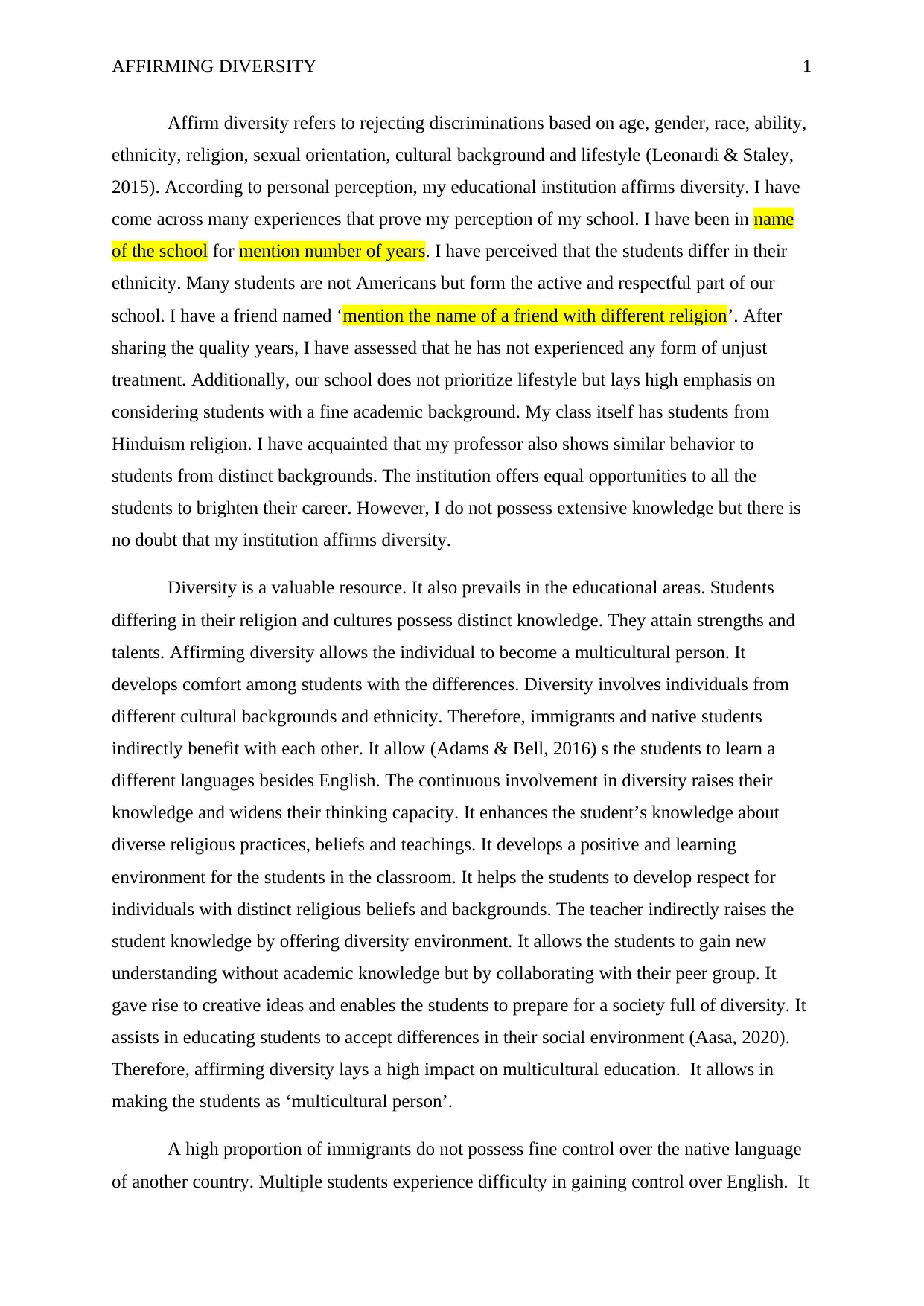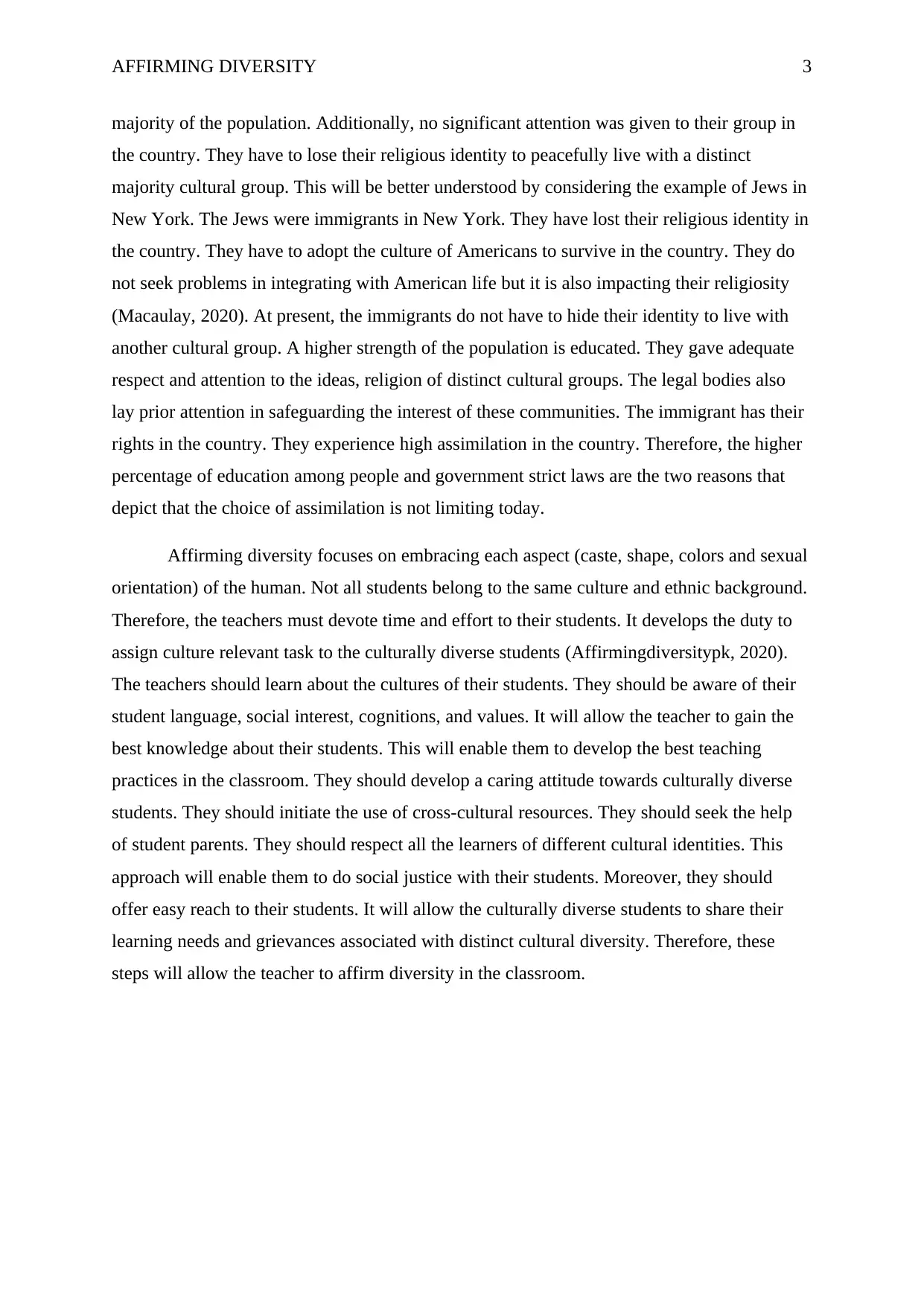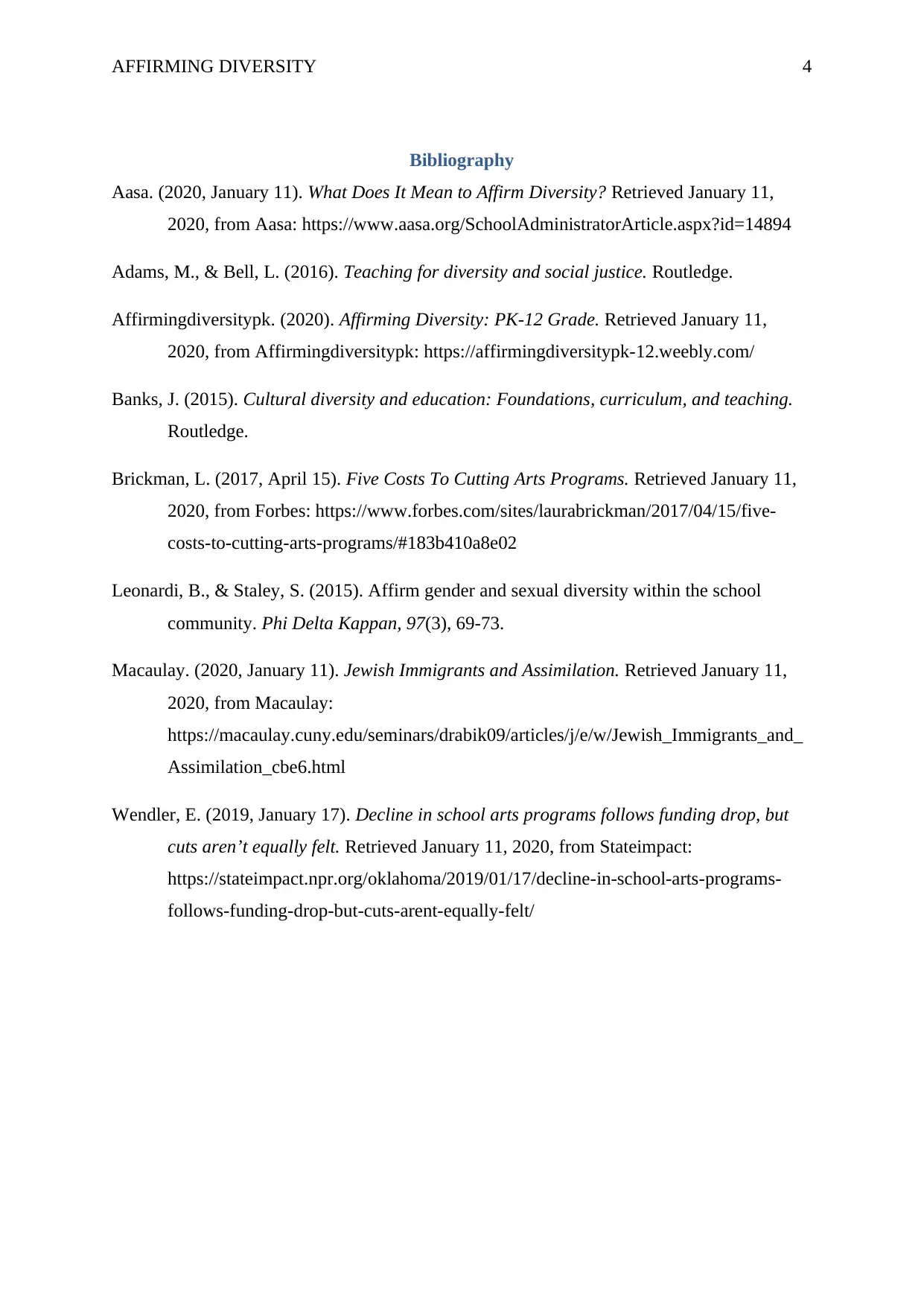Affirming Diversity: Sociological Analysis of Educational Practices
VerifiedAdded on 2022/08/26
|5
|1657
|84
Essay
AI Summary
This essay explores the concept of affirming diversity within educational institutions, highlighting its significance in rejecting discrimination based on various factors such as age, gender, race, religion, and cultural background. It examines how affirming diversity fosters a multicultural environment, enhances students' knowledge, and promotes respect for diverse beliefs. The essay also addresses challenges faced by immigrant students, particularly in language acquisition, and suggests strategies for teachers to support their learning. Furthermore, it discusses the impact of budget cuts on art programs and the importance of maintaining these programs to ensure equal opportunities for all students. Finally, the essay contrasts assimilation with affirmation, emphasizing the importance of embracing individual identities and promoting social justice in the classroom. Desklib offers a platform for students to access similar essays and study resources.

RUNNING HEAD: AFFIRMING DIVERSITY
SOCIOLOGY
AFFIRMING DIVERSITY
SOCIOLOGY
AFFIRMING DIVERSITY
Paraphrase This Document
Need a fresh take? Get an instant paraphrase of this document with our AI Paraphraser

AFFIRMING DIVERSITY 1
Affirm diversity refers to rejecting discriminations based on age, gender, race, ability,
ethnicity, religion, sexual orientation, cultural background and lifestyle (Leonardi & Staley,
2015). According to personal perception, my educational institution affirms diversity. I have
come across many experiences that prove my perception of my school. I have been in name
of the school for mention number of years. I have perceived that the students differ in their
ethnicity. Many students are not Americans but form the active and respectful part of our
school. I have a friend named ‘mention the name of a friend with different religion’. After
sharing the quality years, I have assessed that he has not experienced any form of unjust
treatment. Additionally, our school does not prioritize lifestyle but lays high emphasis on
considering students with a fine academic background. My class itself has students from
Hinduism religion. I have acquainted that my professor also shows similar behavior to
students from distinct backgrounds. The institution offers equal opportunities to all the
students to brighten their career. However, I do not possess extensive knowledge but there is
no doubt that my institution affirms diversity.
Diversity is a valuable resource. It also prevails in the educational areas. Students
differing in their religion and cultures possess distinct knowledge. They attain strengths and
talents. Affirming diversity allows the individual to become a multicultural person. It
develops comfort among students with the differences. Diversity involves individuals from
different cultural backgrounds and ethnicity. Therefore, immigrants and native students
indirectly benefit with each other. It allow (Adams & Bell, 2016) s the students to learn a
different languages besides English. The continuous involvement in diversity raises their
knowledge and widens their thinking capacity. It enhances the student’s knowledge about
diverse religious practices, beliefs and teachings. It develops a positive and learning
environment for the students in the classroom. It helps the students to develop respect for
individuals with distinct religious beliefs and backgrounds. The teacher indirectly raises the
student knowledge by offering diversity environment. It allows the students to gain new
understanding without academic knowledge but by collaborating with their peer group. It
gave rise to creative ideas and enables the students to prepare for a society full of diversity. It
assists in educating students to accept differences in their social environment (Aasa, 2020).
Therefore, affirming diversity lays a high impact on multicultural education. It allows in
making the students as ‘multicultural person’.
A high proportion of immigrants do not possess fine control over the native language
of another country. Multiple students experience difficulty in gaining control over English. It
Affirm diversity refers to rejecting discriminations based on age, gender, race, ability,
ethnicity, religion, sexual orientation, cultural background and lifestyle (Leonardi & Staley,
2015). According to personal perception, my educational institution affirms diversity. I have
come across many experiences that prove my perception of my school. I have been in name
of the school for mention number of years. I have perceived that the students differ in their
ethnicity. Many students are not Americans but form the active and respectful part of our
school. I have a friend named ‘mention the name of a friend with different religion’. After
sharing the quality years, I have assessed that he has not experienced any form of unjust
treatment. Additionally, our school does not prioritize lifestyle but lays high emphasis on
considering students with a fine academic background. My class itself has students from
Hinduism religion. I have acquainted that my professor also shows similar behavior to
students from distinct backgrounds. The institution offers equal opportunities to all the
students to brighten their career. However, I do not possess extensive knowledge but there is
no doubt that my institution affirms diversity.
Diversity is a valuable resource. It also prevails in the educational areas. Students
differing in their religion and cultures possess distinct knowledge. They attain strengths and
talents. Affirming diversity allows the individual to become a multicultural person. It
develops comfort among students with the differences. Diversity involves individuals from
different cultural backgrounds and ethnicity. Therefore, immigrants and native students
indirectly benefit with each other. It allow (Adams & Bell, 2016) s the students to learn a
different languages besides English. The continuous involvement in diversity raises their
knowledge and widens their thinking capacity. It enhances the student’s knowledge about
diverse religious practices, beliefs and teachings. It develops a positive and learning
environment for the students in the classroom. It helps the students to develop respect for
individuals with distinct religious beliefs and backgrounds. The teacher indirectly raises the
student knowledge by offering diversity environment. It allows the students to gain new
understanding without academic knowledge but by collaborating with their peer group. It
gave rise to creative ideas and enables the students to prepare for a society full of diversity. It
assists in educating students to accept differences in their social environment (Aasa, 2020).
Therefore, affirming diversity lays a high impact on multicultural education. It allows in
making the students as ‘multicultural person’.
A high proportion of immigrants do not possess fine control over the native language
of another country. Multiple students experience difficulty in gaining control over English. It

AFFIRMING DIVERSITY 2
develops the responsibility of a teacher to assist the students to improve their control over the
language. They should make sure that immigrant students regularly share a conversation with
students that speak English as their native language. They should share the benefits of
knowing English as their second language. They should timely boost the morale of the
students. It will raise their motivation to excel in their learning a non-native language. The
teacher should positively correct the students. They should develop a learning environment
for such students. They must store comics and games in English. They should offer
supportive material to raise their learning. They should do not heavily rely on academic
sources (books and videos) but rather they must conduct fun activities. These activities might
include watching movies or simple quizzes regarding the English language. They should seek
the help of the school to regularly conduct English language classes for the students (Banks,
2015). Therefore, minor efforts of the teacher will develop English language learning among
the students.
The key focus of every educational institution is not profit. Some lay emphasis on
devoting their service to the economically deprived and culturally marginalized students.
These institutions educate students that possess a lack of monetary resources. They
experience hardship in generating fund to develop art programs in schools. The schools face
difficulty in attaining certified art teachers in rural areas. Additionally, they do not ask for
funds from students as they are already economically deprived. Additionally, it limits the
students to gain possible knowledge about the art of the country (Brickman, 2017). Another
reason for the cut of the art program is to shrink budget from the legal bodies. The
researcher’s states that cut of art programs will deepen the inequality between wealthy and
poor students. The students will fail to develop music, dance, painting and drawing skills
among the students. The students that attain their interest in art will not be able to excel in
this area. This is because non-availability of teachers and cut of art programs will limit them
to improve their art. They added that the cut of art program will gradually minimize its
essence among the students (Wendler, 2019). Therefore, it can be stated that there are
multiple reasons for cutting art programs. Hence, it will lay a direct impact on student
knowledge.
Assimilation is acceptance of ideas and information whereas affirmation refers to
supporting and encouraging the ideas and thoughts. Previously, the immigrant, as well as a
minority of the cultural population, did not possess adequate individual rights. They do not
have their separate distinct identity in the country. They have to consider themselves in the
develops the responsibility of a teacher to assist the students to improve their control over the
language. They should make sure that immigrant students regularly share a conversation with
students that speak English as their native language. They should share the benefits of
knowing English as their second language. They should timely boost the morale of the
students. It will raise their motivation to excel in their learning a non-native language. The
teacher should positively correct the students. They should develop a learning environment
for such students. They must store comics and games in English. They should offer
supportive material to raise their learning. They should do not heavily rely on academic
sources (books and videos) but rather they must conduct fun activities. These activities might
include watching movies or simple quizzes regarding the English language. They should seek
the help of the school to regularly conduct English language classes for the students (Banks,
2015). Therefore, minor efforts of the teacher will develop English language learning among
the students.
The key focus of every educational institution is not profit. Some lay emphasis on
devoting their service to the economically deprived and culturally marginalized students.
These institutions educate students that possess a lack of monetary resources. They
experience hardship in generating fund to develop art programs in schools. The schools face
difficulty in attaining certified art teachers in rural areas. Additionally, they do not ask for
funds from students as they are already economically deprived. Additionally, it limits the
students to gain possible knowledge about the art of the country (Brickman, 2017). Another
reason for the cut of the art program is to shrink budget from the legal bodies. The
researcher’s states that cut of art programs will deepen the inequality between wealthy and
poor students. The students will fail to develop music, dance, painting and drawing skills
among the students. The students that attain their interest in art will not be able to excel in
this area. This is because non-availability of teachers and cut of art programs will limit them
to improve their art. They added that the cut of art program will gradually minimize its
essence among the students (Wendler, 2019). Therefore, it can be stated that there are
multiple reasons for cutting art programs. Hence, it will lay a direct impact on student
knowledge.
Assimilation is acceptance of ideas and information whereas affirmation refers to
supporting and encouraging the ideas and thoughts. Previously, the immigrant, as well as a
minority of the cultural population, did not possess adequate individual rights. They do not
have their separate distinct identity in the country. They have to consider themselves in the
⊘ This is a preview!⊘
Do you want full access?
Subscribe today to unlock all pages.

Trusted by 1+ million students worldwide

AFFIRMING DIVERSITY 3
majority of the population. Additionally, no significant attention was given to their group in
the country. They have to lose their religious identity to peacefully live with a distinct
majority cultural group. This will be better understood by considering the example of Jews in
New York. The Jews were immigrants in New York. They have lost their religious identity in
the country. They have to adopt the culture of Americans to survive in the country. They do
not seek problems in integrating with American life but it is also impacting their religiosity
(Macaulay, 2020). At present, the immigrants do not have to hide their identity to live with
another cultural group. A higher strength of the population is educated. They gave adequate
respect and attention to the ideas, religion of distinct cultural groups. The legal bodies also
lay prior attention in safeguarding the interest of these communities. The immigrant has their
rights in the country. They experience high assimilation in the country. Therefore, the higher
percentage of education among people and government strict laws are the two reasons that
depict that the choice of assimilation is not limiting today.
Affirming diversity focuses on embracing each aspect (caste, shape, colors and sexual
orientation) of the human. Not all students belong to the same culture and ethnic background.
Therefore, the teachers must devote time and effort to their students. It develops the duty to
assign culture relevant task to the culturally diverse students (Affirmingdiversitypk, 2020).
The teachers should learn about the cultures of their students. They should be aware of their
student language, social interest, cognitions, and values. It will allow the teacher to gain the
best knowledge about their students. This will enable them to develop the best teaching
practices in the classroom. They should develop a caring attitude towards culturally diverse
students. They should initiate the use of cross-cultural resources. They should seek the help
of student parents. They should respect all the learners of different cultural identities. This
approach will enable them to do social justice with their students. Moreover, they should
offer easy reach to their students. It will allow the culturally diverse students to share their
learning needs and grievances associated with distinct cultural diversity. Therefore, these
steps will allow the teacher to affirm diversity in the classroom.
majority of the population. Additionally, no significant attention was given to their group in
the country. They have to lose their religious identity to peacefully live with a distinct
majority cultural group. This will be better understood by considering the example of Jews in
New York. The Jews were immigrants in New York. They have lost their religious identity in
the country. They have to adopt the culture of Americans to survive in the country. They do
not seek problems in integrating with American life but it is also impacting their religiosity
(Macaulay, 2020). At present, the immigrants do not have to hide their identity to live with
another cultural group. A higher strength of the population is educated. They gave adequate
respect and attention to the ideas, religion of distinct cultural groups. The legal bodies also
lay prior attention in safeguarding the interest of these communities. The immigrant has their
rights in the country. They experience high assimilation in the country. Therefore, the higher
percentage of education among people and government strict laws are the two reasons that
depict that the choice of assimilation is not limiting today.
Affirming diversity focuses on embracing each aspect (caste, shape, colors and sexual
orientation) of the human. Not all students belong to the same culture and ethnic background.
Therefore, the teachers must devote time and effort to their students. It develops the duty to
assign culture relevant task to the culturally diverse students (Affirmingdiversitypk, 2020).
The teachers should learn about the cultures of their students. They should be aware of their
student language, social interest, cognitions, and values. It will allow the teacher to gain the
best knowledge about their students. This will enable them to develop the best teaching
practices in the classroom. They should develop a caring attitude towards culturally diverse
students. They should initiate the use of cross-cultural resources. They should seek the help
of student parents. They should respect all the learners of different cultural identities. This
approach will enable them to do social justice with their students. Moreover, they should
offer easy reach to their students. It will allow the culturally diverse students to share their
learning needs and grievances associated with distinct cultural diversity. Therefore, these
steps will allow the teacher to affirm diversity in the classroom.
Paraphrase This Document
Need a fresh take? Get an instant paraphrase of this document with our AI Paraphraser

AFFIRMING DIVERSITY 4
Bibliography
Aasa. (2020, January 11). What Does It Mean to Affirm Diversity? Retrieved January 11,
2020, from Aasa: https://www.aasa.org/SchoolAdministratorArticle.aspx?id=14894
Adams, M., & Bell, L. (2016). Teaching for diversity and social justice. Routledge.
Affirmingdiversitypk. (2020). Affirming Diversity: PK-12 Grade. Retrieved January 11,
2020, from Affirmingdiversitypk: https://affirmingdiversitypk-12.weebly.com/
Banks, J. (2015). Cultural diversity and education: Foundations, curriculum, and teaching.
Routledge.
Brickman, L. (2017, April 15). Five Costs To Cutting Arts Programs. Retrieved January 11,
2020, from Forbes: https://www.forbes.com/sites/laurabrickman/2017/04/15/five-
costs-to-cutting-arts-programs/#183b410a8e02
Leonardi, B., & Staley, S. (2015). Affirm gender and sexual diversity within the school
community. Phi Delta Kappan, 97(3), 69-73.
Macaulay. (2020, January 11). Jewish Immigrants and Assimilation. Retrieved January 11,
2020, from Macaulay:
https://macaulay.cuny.edu/seminars/drabik09/articles/j/e/w/Jewish_Immigrants_and_
Assimilation_cbe6.html
Wendler, E. (2019, January 17). Decline in school arts programs follows funding drop, but
cuts aren’t equally felt. Retrieved January 11, 2020, from Stateimpact:
https://stateimpact.npr.org/oklahoma/2019/01/17/decline-in-school-arts-programs-
follows-funding-drop-but-cuts-arent-equally-felt/
Bibliography
Aasa. (2020, January 11). What Does It Mean to Affirm Diversity? Retrieved January 11,
2020, from Aasa: https://www.aasa.org/SchoolAdministratorArticle.aspx?id=14894
Adams, M., & Bell, L. (2016). Teaching for diversity and social justice. Routledge.
Affirmingdiversitypk. (2020). Affirming Diversity: PK-12 Grade. Retrieved January 11,
2020, from Affirmingdiversitypk: https://affirmingdiversitypk-12.weebly.com/
Banks, J. (2015). Cultural diversity and education: Foundations, curriculum, and teaching.
Routledge.
Brickman, L. (2017, April 15). Five Costs To Cutting Arts Programs. Retrieved January 11,
2020, from Forbes: https://www.forbes.com/sites/laurabrickman/2017/04/15/five-
costs-to-cutting-arts-programs/#183b410a8e02
Leonardi, B., & Staley, S. (2015). Affirm gender and sexual diversity within the school
community. Phi Delta Kappan, 97(3), 69-73.
Macaulay. (2020, January 11). Jewish Immigrants and Assimilation. Retrieved January 11,
2020, from Macaulay:
https://macaulay.cuny.edu/seminars/drabik09/articles/j/e/w/Jewish_Immigrants_and_
Assimilation_cbe6.html
Wendler, E. (2019, January 17). Decline in school arts programs follows funding drop, but
cuts aren’t equally felt. Retrieved January 11, 2020, from Stateimpact:
https://stateimpact.npr.org/oklahoma/2019/01/17/decline-in-school-arts-programs-
follows-funding-drop-but-cuts-arent-equally-felt/
1 out of 5
Related Documents
Your All-in-One AI-Powered Toolkit for Academic Success.
+13062052269
info@desklib.com
Available 24*7 on WhatsApp / Email
![[object Object]](/_next/static/media/star-bottom.7253800d.svg)
Unlock your academic potential
Copyright © 2020–2025 A2Z Services. All Rights Reserved. Developed and managed by ZUCOL.




